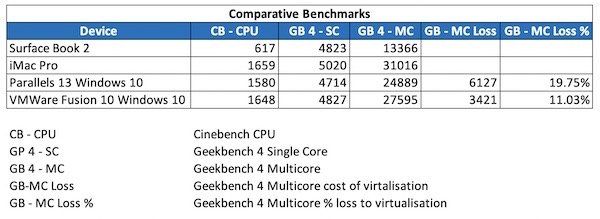Desktop Virtualzation - It's Brilliant
15/08/18 20:29 Filed in: Industry
How good is desktop virtualization, and what's the performance impact of virtualising stuff?
====
The ability to run multiple different operating systems on your laptop has proven to be invaluable for me - it's just so, so useful. I'm often on many different sites all with slightly different environments, or I'll be needing to build & test server based stuff. Being able to do that on my laptop has saved me so much time & effort.
As an Apple Mac user, I'm always coming across scenarios where I need to run Windows - whether server or desktop - so being able to fire up multiple different versions all at the same time saves a ton of time. No rebooting into a single copy of Windows in BootCamp for example. My normal productivity environment for example is an Apple Mac running Windows 10 in Parallels Desktop.
One thing I get asked about a lot is what's the impact of virtualising Windows like this, just how usable is it? Well, it's brilliantly usable, just as much as most physical devices (I.e. Natively running Windows) I've used. There has to be a performance impact though, right? Yes, yes there is, but it's relatively minor in reality.
I've done some benchmarking below showing:
- Cinebench scores natively in MacOS, and in Windows 10 running in both Parallels Desktop 13 and VMWare Fusion 10.
- Geekbench 4 scores natively in MacOS, and in Windows 10 running in both Parallels Desktop 13 and VMWare Fusion 10.
Anyway, these figures are shown below.

Now, I know it's a bit unfair to compare the Surface Book 2 to an iMac Pro like I have above, but even on my MacBook Pro I get better performance in Windows 10 virtualised than I do natively on the Surface Book 2, and the SB2 Is hardly a slouch.
It's interesting to see the differences in the performance for VMWare Fusion and Parallels by the way. I tend to use Parallels for my Windows 10 setups, and VMWare Fusion for my server stuff, however looking at the above I may now reconsider this. More testing required. I will say though that in all of the graphics tests Parallels 13 seems significantly faster than Fusion.
Anyway, my general point being that running an OS virtualised for general day to day use is amazing. Being able to take snapshots, to roll-back etc. when testing is invaluable. As is having standard builds of Windows available for a simple copy, rather than having to build fresh very single time I need a machine saves me tons of time.
You can do this on Windows too of course using HyperV - this is included in Windows 10 Enterprise or Professional. Anyway, you can read about that here.
blog comments powered by Disqus
